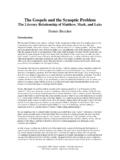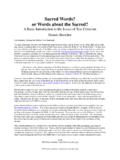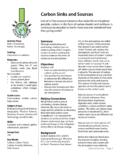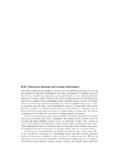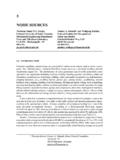Transcription of JEDP: Sources in the Pentateuch - CRI/Voice
1 1 Copyright 2003, Dennis Bratcher, All Rights Reserved The Christian Resource Institute - JEDP: Sources in the Pentateuch Dennis Bratcher The letters JEDP are a designation used by scholars to identify the component parts or Sources that they understand were used to compile the first five books of the Old Testament. There have been various opinions as to whether these Sources were written or oral traditions, and whether each source represents an independent strand or a stage in the development of an older source. This particular way of studying the biblical text is called source analysis or very broadly literary analysis, emphasizing that the object of study is the biblical text itself to distinguish it from historical analysis that focused on reconstructing history apart from the biblical text. There is a long and interesting history of the development of this method of biblical study that dates back to Jewish scholars in the 11th century AD.
2 Contrary to some anti-scholarly rhetoric that is common in some church traditions even today, there was never any intent in this method to discredit any aspect of the Bible. That arose more as a reaction against the challenge this investigation raised concerning established ideas about Mosaic authorship that were deeply ingrained in some church tradition. The conclusion that the material of the Pentateuch is composite, written by different people or different communities over a long period of time, came from a study of the biblical text itself apart from the dogma and traditional interpretation that had been in place for centuries. That dogma itself, however, was not a conclusion arrived at by investigation, but by acceptance of still earlier tradition. It was not until the Reformation and the Enlightenment that systematic questions could be asked and investigated in these areas (recall that Galileo tried that in the area of natural science, and was quickly silenced by the church because it was too disquieting to established views of truth!)
3 There were excesses in this endeavor, however. For the first time in the church, Scripture could be investigated apart from the authority of the church in telling people what they must believe and what the text meant. Unfortunately, that led to some people focusing more on the process of investigation than what they were investigating. By the beginning of the 19th century, some scholars were so enamored with this method of biblical study that the number of posited Sources for the Pentateuch greatly multiplied. Scholars also grew increasingly confident in their ability to identify these Sources , sometimes as many as three in a single verse. This excessive zeal to dissect the biblical text into component parts led to a backlash against such methods from some circles. That reaction itself became overly zealous in the other direction, and, when combined with emerging Fundamentalism in the 1920s, resulted in the anti-scholarly rhetoric and biases toward biblical study that still echo in the church today.
4 2 Copyright 2003, Dennis Bratcher, All Rights Reserved The Christian Resource Institute - Scholarship gradually realized the excesses, since all such scholarship must be done in a larger community, and began to modify perspectives, both in terms of the number of identifiable Sources and the confidence in being able to identify them. Also there arose a steady recovery of a focus on the whole of the biblical text as well as its component parts. Today, some have declared source criticism dead as a specific biblical study tool. However, even though methods of biblical study have moved far beyond such minute dissection of the text, the insight that the Pentateuch is composite and "grew" over a long period of time has been a lasting contribution of this method of study. While the early formulations of JEDP may not be widely accepted today among many biblical scholars, there is little question that the Pentateuch , and the larger biblical text, is composed of diverse strands of tradition compiled over the course of many years.
5 This is in line with what New Testament scholars understand about the growth of the Gospel traditions as well, witnessed by the fact that we still have four " Sources " of those traditions in the four Gospels. So, it would be helpful for students of Scripture to understand the approach of source criticism in order to gain a better appreciation not only of the biblical text, but of the development of modern biblical studies. Originally, JEDP referred to what scholars had identified as the four main Sources of the Pentateuch . There were various perspectives as to the details, but this was generally called the "documentary hypothesis" of biblical origins ( Sources = documents). This referred to the conclusion that the Pentateuch as we have it had been composed or complied from a variety of previously existing documents or Sources . The letters were simply the abbreviations for those earlier documents or Sources .
6 The earliest strands of the biblical traditions, dating perhaps to the time of the Davidic monarchy (1,000 BC), were given the designations "J" and "E". The designation J was given to material that primarily used the proper name for God, YHWH (we are not sure how it was pronounced; German scholars developed the method and used the letter "J" since that is the German equivalent of "Y" in Hebrew). It was posited that this material was written or preserved in the Southern Kingdom of Judah after the division of the Kingdom in 922 BC, and perhaps as late as the 8th century BC. It contained the traditions of the Davidic monarchy and the establishment of Jerusalem as the center of worship, as well as recounting the story of the emergence of Israel as a people under God s guidance. While there is some legal material in these Sources , most of it is epic narrative, traditional recounting of the origins of a people and their journey through history.
7 E was similar material that used the generic term for deity (elohim) in referring to God. It originated in the Northern Kingdom of Israel, perhaps earlier than J before the establishment of the monarchy, although most placed it around the 8th century BC. Rather than material about the Davidic monarchy, E contained the tribal traditions of the conquest of the land and the traditions about the covenant and the worship centers outside Jerusalem. D was the designation given to deuteronomic material. This was understood to be instructional or preaching material that used language, concepts, and theological 3 Copyright 2003, Dennis Bratcher, All Rights Reserved The Christian Resource Institute - perspectives very similar to that found in the Book of Deuteronomy as well as some of the prophets ( , Jeremiah). It focused on faithfulness to God using the covenant traditions as a basis, and was concerned with obedience as proper response to God s grace.
8 It also included much of the legal material that revolved around obedience to God as faithfulness to the Torah. There was always debate about the exact time frame of this material, but it was generally agreed that there were two distinct phases in the editing or "redaction" of D material. Some saw it as living tradition that was constantly reapplied within the community. It contained traditions from Moses, but scholars thought that an early form of Deuteronomy was in place as a written document during the reign of Josiah (c. 621 BC), which he used as a basis for his reforms. A later version of this material was reedited after the exile to apply the theology of Mosaic traditions to the crisis of the exile. The perspective of D was also thought to have influenced some of the historical traditions in Samuel-Kings and some of the prophetic traditions, especially that of Jeremiah. The P material was understood to be priestly material, and focused on the concerns of priests serving in the Jerusalem temple.
9 This would include technical record keeping and legal traditions related to the proper functioning of the Temple and its associated activities. It included material such as detailed regulations about how to observe festivals, the counting of days, the ordering of events into sequence, genealogies and statistics, as well as reflective theological material that related to the keeping of religious law. Like D, or Deuteronomic material, this priestly material was understood to contain traditions from all periods of Israel s history. But the final shaping of the P traditions are considered late in the development of the final form of the Pentateuch , since the priests emerged as the leaders and wielders of power only after the return from exile. Therefore, most of the priestly material, in the form we have it now, is usually understood as post-exilic in the fifth century BC or later. There was always debate over whether there was ever an independent "P" document, or whether this material was simply a rewriting of other traditional material from the perspective of priestly concerns (such as the "second" creation account of Genesis 1).
10 This re-writing of older material is called "redaction" (editing) and this led to ongoing discussion whether the "redactor" was simply a compiler of other material or was a creative author. This same discussion relates to the Gospels as well, where it is more obvious that common material from traditional Sources is being used, yet is given unique theological slants by each of the four authors. Today, while there are still challenges from some to the idea of Sources in the Pentateuch , it is generally accepted even by very conservative scholars. However, there have been significant modifications from 100 years ago and the whole scenario of "source criticism" has been vastly simplified. Rather than " Sources " as specific written documents many scholars now talk about traditions, emphasizing that Scripture grew out of the ongoing life of a worshipping community rather than simply being composed by a single 4 Copyright 2003, Dennis Bratcher, All Rights Reserved The Christian Resource Institute - individual at one time and then merely edited.
